|
Notes: The first Latchford station was situated on the Warrington & Stockport Railway (W&S) which opened on 1 November 1853. The W&S route was authorised on 3 July 1851 as a line of the Warrington and Altrincham Railway (W&A) that would run to Warrington from a connection with the Manchester South Junction & Altrincham Railway (MSJAR) at Timperley Junction. At Warrington the W&A was authorised to make an end-on connection with the SHC&RC Garston and Warrington line and with the London & North Western Railway (LNWR) and the Birkenhead Joint Railway (BJR) at Walton Junction. On 4 August 1853 the W&A changed its name to the W&S.
At the time of opening the station was called Latchford & Grappenhall Road. It was located on the west side of what was then Hill Top Road which crossed the line on a level crossing. The W&S was a double-track railway and the station was provided with two platforms. The main facilities were on the up (Broadheath direction) platform and included a booking office, waiting rooms, toilets and a house for the stationmaster.The smart, two-storey brick building had a pitched slate roof parallel to the platform, and the two upper windows were steeply gabled as was the entrance to the platform below them. The gables were treated to ornamental bargeboards. Behind the platform frontage the building extended back with a pitched roof at right angles to the platform. A single-storey wing beneath a pitched roof extended eastwards from the two-storey structure. At the east end of the platform the crossing keeper’s single-storey cottage complemented the design of the main building.
 |
On the down platform there was a less ambitious single-storey structure with a tall pitched roof, but its gable ends were treated to attractive bargeboards.
At the eastern end of the down platform was a signal box which controlled the level crossing. West of the station, on the north side of the line, there was a goods siding and small yard.
At the time of opening the W&S ran from a temporary station at Warrington Wilderspool to Broadheath. Broadheath was over a mile from Altrincham and was nowhere near Stockport . A comment made at the time was that the W&S went ‘from nowhere to nowhere’. It had not been the intention of the W&S to have an isolated line. The purpose of the W&S had been to create a route from Warrington to Manchester via the MSJAR railway. In doing so the SHC&RC would be able to reach Manchester from Garston and the BJR would have a link to the city from its network. The problem was that the MSJAR was under the joint ownership of the London North Western Railway (LNWR) & the Manchester, Sheffield & Lincolnshire Railway (MS&LR). The LNWR was hostile to the idea of trains running between the BJR and the SHC&RC lines and Manchester as they saw this as creating routes to its own. For that reason the LNWR obstructed the W&S, putting it in a precarious financial position.
A bridge over the Mersey was completed in the early months of 1854 and the W&S opened to Warrington Arpley on 1 May 1854. On the same day the line was also extended to Timperley Junction where it connected to the MSJAR. Latchford & Grappenhall Road was renamed ‘Latchford’.
Legal wrangling followed, and an arbitrator gave the W&S the right to run its trains over the MSJAR line to Manchester Oxford Road but at a financial cost that the W&S considered to be too high. The W&S had no choice but to pay, and their trains started to run between Warrington Arpley and Manchester Oxford Road on 31 October 1854.
Things went from bad to worse for the W&S. Companies such as the BJR had obtained running rights over the line and the W&S had anticipated healthy receipts from them. The Great Western Railway (GWR) was a partner in the BJR and it intended to run services to Manchester via the W&S. In spring 1855 the line from Warrington Arpley to Walton Junction opened (the junction being just to the west of the station) making the GWR plan feasible. The problem was that the GWR and the LNWR were hostile to each other and the LNWR would not allow the GWR to use the MSJAR. The W&S had obtained an Act to build a line to Stockport at the time of its name change, but because of the turn of events it did not have the funds to proceed and the powers lapsed. The W&S company was never to reach Stockport.
In 1856 agreement was reached with the LNWR to extend some of the MSJAR trains to Warrington Arpley and effectively use the W&S as an extension of that line. The arrangement made for a better passenger service and one that delivered an operating surplus. Operation of the service which called at Latchford began on 1 October 1856.
In 1857 the working relationship between the MS&LR and LNWR fractured and the companies became enemies. A railway war ensued and the MS&LR began to negotiate with the GWR. The MS&LR was now more than happy to allow the GWR to reach Manchester via the MSJAR line, which would have put the W&S on a more sound financial footing. The LNWR was quick to act, however, and it opened up negotiations with the GWR, agreeing in November 1858 to allow them to reach Manchester via LNWR lines.
The MS&LR began operating passenger services between Manchester and Garston, where an onward connection to Liverpool could be made by omnibus. They also introduced a service between Manchester and Chester. This was in direct competition with the LNWR and gave Latchford perhaps the most diverse service it ever had.
For a brief period during the railway war the W&S line had taken on a role of importance just as its promotors had anticipated. During 1858 the SHC&RC and the MS&LR considered leasing the W&S but in autumn 1858 the railway war ended. It had cost all of the companies a great deal of money as they had cut fares and put on services in competition with each other. In November 1858 Latchford lost the MS&LR services between Manchester and Garston/Chester.
To counter any future threats the LNWR took out a lease of the W&S on 13 August 1859 and absorbed it fully on 1 January 1861.
On 15 February 1864 a line was opened from Speke Junction (to the east of Garston) to Edge Hill (Liverpool) which allowed the LNWR to run trains from Latchford direct to Liverpool. On 1 September 1864 the LNWR absorbed the SHC&RC. The LNWR operated mostly local trains from Latchford but it did use the line between Garston and Timperley Junction extensively for goods services.
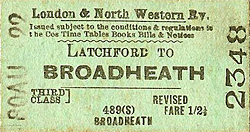 On 1 December 1865 the former W&S was finally connected to Stockport when the Cheshire Lines Committee (CLC) opened a line from Broadheath (Deansgate Junction) to Stockport Tiviot Dale. The CLC was a joint railway of the MS&LR, the GNR and the Midland Railway (MR). The CLC had obtained running rights over the line between Garston and Broadheath, and they had taken over the Garston & Liverpool Railway (opened 1 May 1864) giving them a route between Stockport and Liverpool. One of the CLC partners was the MS&LR, so a route was also available between Manchester and Liverpool via Latchford and the CLC introduced passenger services onto the line. On 1 December 1865 the former W&S was finally connected to Stockport when the Cheshire Lines Committee (CLC) opened a line from Broadheath (Deansgate Junction) to Stockport Tiviot Dale. The CLC was a joint railway of the MS&LR, the GNR and the Midland Railway (MR). The CLC had obtained running rights over the line between Garston and Broadheath, and they had taken over the Garston & Liverpool Railway (opened 1 May 1864) giving them a route between Stockport and Liverpool. One of the CLC partners was the MS&LR, so a route was also available between Manchester and Liverpool via Latchford and the CLC introduced passenger services onto the line.
Once again, however, the rivalry between companies had an impact on the former W&S line. The LNWR did all that it could to inconvenience the CLC trains. This resulted in the CLC building its own line between Garston and Manchester, with a branch to Stockport. The line opened in two stages on 1 August and 2 September 1873 and the former W&S route lost its CLC services.
Services settled down into a familiar pattern with passenger trains running between Liverpool Lime Street and Manchester London Road, with some shorter workings between Warrington and Manchester and some workings to Stockport.
In 1885 the Manchester Ship Canal Company (MSCC) obtained an Act to create a major transport artery which would cut through the course of the railway at Latchford. The canal required a clearance of 75ft above the water line and the railway companies, who had lobbied hard to prevent the canal from being built, did not want swing bridges which would interfere with the operation of their trains. The solution at Latchford (and elsewhere) was to build a deviation to the line and a high level bridge at the canal’s expense. The deviation was built to the north of Latchford station. It commenced at Wilderspool and took the line up to the required 75ft above the canal. A new station for Latchford was built on the deviation.
The deviation was completed by February 1893 and the LNWR commenced running goods trains over it. They continued to use the original line for a few weeks so as to be sure that all was well with the deviation. On 10 July 1893 passenger services were switched to the deviation line and the original Latchford station was closed. The line was then cut a short distance to the east of the station and the canal was excavated. The Manchester Ship Canal opened in 1894.
A railway was retained through the original Latchford station to serve sidings on the northern bank of the canal; it was, however, singled through the station site. The canal ran directly behind the down platform and severed Hill Top Road. The level crossing was therefore of little importance other than as a link to the canal bank and it became unmanned. The signal box at Latchford station was demolished. The main station building survived well into the 1960s and the down platform building until the 1980s. The connecting line to the ship canal which ran through the station closed in the late 1960s.
Ticket from Michael Stewart and route map by Alan Young.
Sources:
- Encyclopaedia of British Railway Companies - Christopher Awdry - Guild Publishing 1990
- The Manchester South Junction & Altrincham Railway - Martain Bairstow - Published by Martin Bairstow 2014.
- The Manchester South Junction & Altrincham Railway - Frank Dixon - The Oakwood Press 1994
- The St Helens Railway, Its Rivals and Successors – J M Tolston – The Oakwood Press 1982.
To see stations on the Warrington and Stockport railway click on the station name: Warrington Arpley, Warrington Wilderspool, Latchford (2nd),
Thelwall, Lymm, Heatley &
Warburton, Dunham Massey & Broadheath.
See also the stations on the Garston and Warrington railway: Garston Dock,
Speke, Halebank, Ditton, Ditton Mill, Widnes (1st), Widnes South, Cuerdley, Fidlers
Ferry & Penketh, Sankey
Bridges &
Warrington
Bank Quay Low Level.
|

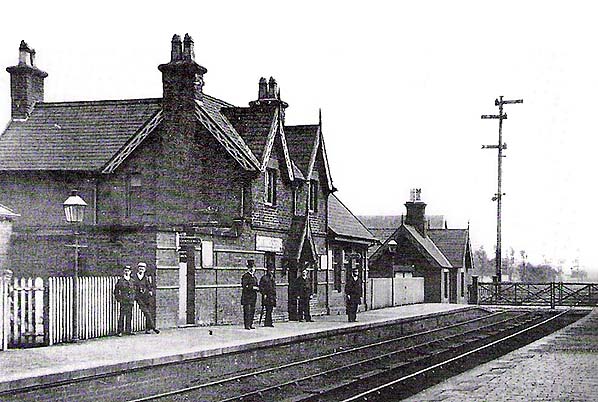
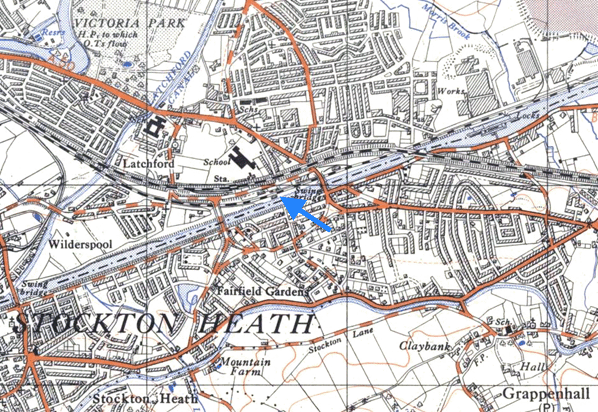
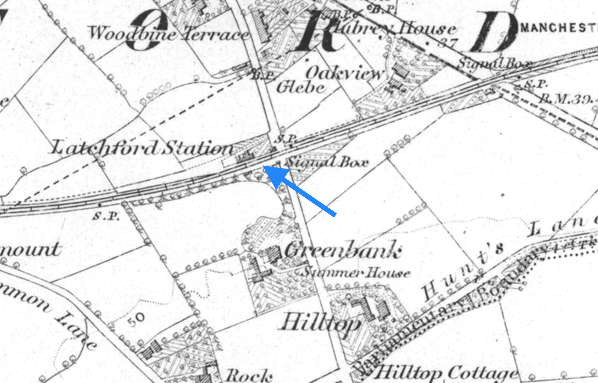
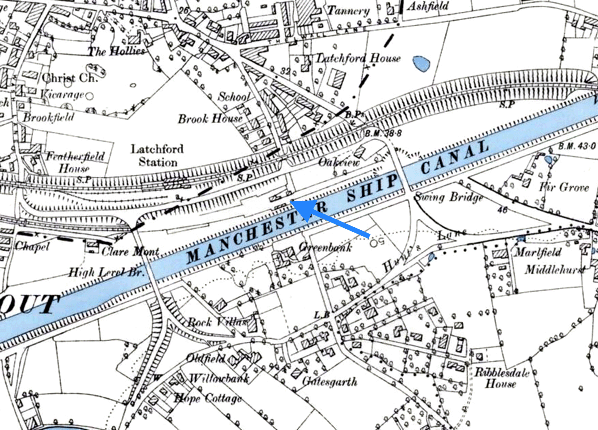
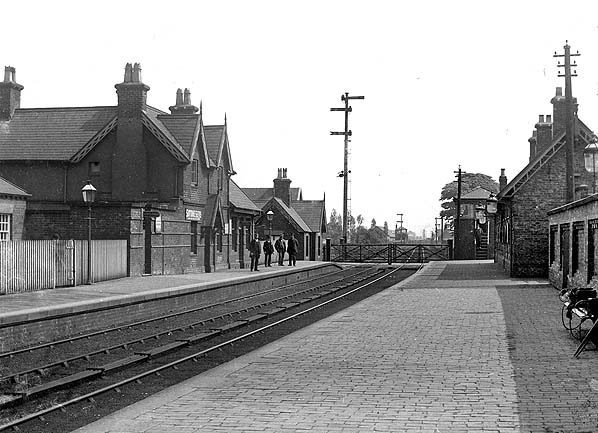
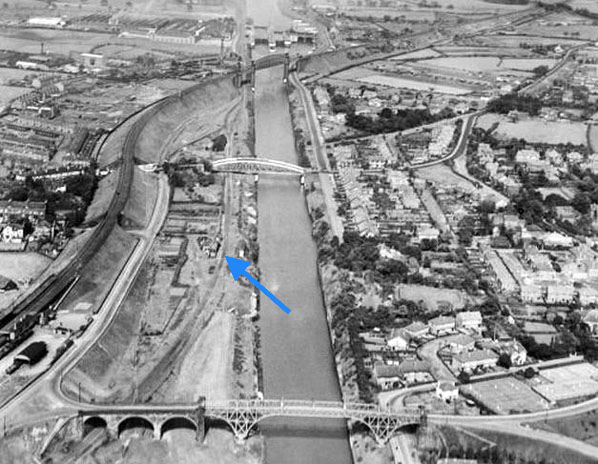
1.jpg)
2.jpg)
.jpg)
.jpg)
 Home Page
Home Page 
 On 1 December 1865 the former W&S was finally connected to Stockport when the Cheshire Lines Committee (CLC) opened a line from Broadheath (Deansgate Junction) to Stockport Tiviot Dale. The CLC was a joint railway of the MS&LR, the GNR and the Midland Railway (MR). The CLC had obtained running rights over the line between Garston and Broadheath, and they had taken over the Garston & Liverpool Railway (opened 1 May 1864) giving them a route between Stockport and Liverpool. One of the CLC partners was the MS&LR, so a route was also available between Manchester and Liverpool via Latchford and the CLC introduced passenger services onto the line.
On 1 December 1865 the former W&S was finally connected to Stockport when the Cheshire Lines Committee (CLC) opened a line from Broadheath (Deansgate Junction) to Stockport Tiviot Dale. The CLC was a joint railway of the MS&LR, the GNR and the Midland Railway (MR). The CLC had obtained running rights over the line between Garston and Broadheath, and they had taken over the Garston & Liverpool Railway (opened 1 May 1864) giving them a route between Stockport and Liverpool. One of the CLC partners was the MS&LR, so a route was also available between Manchester and Liverpool via Latchford and the CLC introduced passenger services onto the line. 